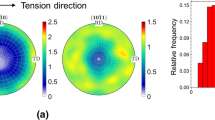Abstract
The stress-strain behavior and the deformation dynamics of compression rolled and hot upset beryllium sheet prepared from SR powder were investigated in tension over the range 25° to 355°C. The true stress-true strain curves were approximated by the relationσ =σ(0) +hε 1/2. Both σ(0) andh decreased with temperature. σ(0) was higher at all temperatures for the compression rolled sheet, whereash was the same for the two materials. The difference in σ(0) was in the athermal component of the stress. The effects of temperature and strain rate on the flow-stress of the polycrystalline sheet agreed with those for prism slip in single crystals. Thermal activation analysis of the deformation dynamics yielded values of 123 to 158 b3 for the activation volume, 1.5×107 sec−1 for the preexponential factor and 1.8 ev (0.18 μb3) for the activation energy,Ho.
Similar content being viewed by others
References
D. McLean:Conf. Int. Metallurgie du Beryllium, Presses, Univ. de France. Paris, 1965, p. 3.
H. Conrad and I. Perlmutter: Beryllium as a Technological Material,Conf. Int. Metallurgie du Beryllium, Presses, Univ. de France, Paris, 1965, p. 319.
H. Conrad: Thermally Activated Deformation of Metals,J. Metals, 1964, vol. 16, p. 582.
F. W. Cooke, M. Herman, and H. Conrad:Met. Trans., 1971, vol. 2, p.
R. N. Orava, G. Stone, and H. Conrad:ASTM Trans. Quart., 1966, vol. 59, p. 171.
H. Conrad, S. Feuerstein, and L. Rice:Mater. Sci. Eng., 1967, vol. 2, p. 157.
H. Conrad and R. Jones: Effects of Interstitial Content and Grain Size on the Mechanical Behavior of Alpha Titanium below 0.4T m , inScience Technology and Application of Titanium, R. Jaffee and N. Promisel, eds., Pergamon Press, Oxford, 1970.
M. I. Jacobson:Beryllium Technology, p. 259. Gordon and Breach, New York, 1966.
J. M. Logerot:Conf. Int. Metallurgie Beryllium, Presses, Univ. de France, Paris, 1965, p. 471.
M. Kawaskiet al.: Studies on the Mechanical Properties of Japanese Beryllium,Conf. Int. Metallurgie Beryllium, Presses, Univ. de France, Paris, 1965, p. 625.
A. E. Riesen and R. T. Ault: Mechanical Properties of Beryllium, WADD-TR-60-425, Sept. 1960.
A. Brown, F. Morrow, and A. Martin:J. Less-Common Metals, 1961, vol. 3, p. 62.
J. Baicry, P. Petrequin, J. P. Gauthier, and M. Weisz:Conf. Int. Metallurgie du Beryllium, Presses Univ. de France, Paris, 1965, p. 385.
W. W. Beaver and B. B. Lympany:Conf. Int. Metallurgie du Beryllium, Presses Univ. de France, Paris, 1965, p. 489.
E. C. Bernett: Evaluation of the Short-Time Mechanical Properties of Structural Beryllium, ASME preprint No. 61-AU-42, presented in Los Angeles, Mar. 12–16, 1961. Abstract only pub.Mech. Eng., 1961, vol. 83, p. 74.
W. J. Salmen and L. P. Gobble:Proc. Am. Soc. Testing Mater., 1962, vol. 162, p. 653.
G. J. Giemza: Development and Evaluation of Structural Beryllium, Martin Co. Report RR-10, April 1959.
W. F. Davenport and W. G. Reufer: Low Temperature Properties of Beryllium, Acronantics Div., Ford Motor Co., DMIC No. 58013, April 2, 1963.
R. Jenkinset al.: Development of Improved Fabricating Methods, Processes and Techniques for Producing Typical Aircraft Shapes from Beryllium, ML-TDR-64-108, May 29, 1964.
P. Regnier, T. M. DuPouy, and Y. Adda:Conf. Int. Metallurgie du Beryllium, p. 273, Pressess Univ. de France, Paris, 1965.
G. London, V. Damiano, and H. Conrad:Trans. TMS-AIME, 1968, vol. 242, p. 979.
H. Conrad, G. London, and V. Damiano:Anisotropy in Single-Crystal Refractory Compounds, vol. 2, F. W. Vahldick and S. A. Mersol, eds., p. 153, Plenum, New York, 1968.
J. Hull and H. Conrad: Thermally Activated Deformation of α-Zirconium and α-Zirconium Alloy below 0.4T m ,FIRL Rept. F-Cl834, Aug. 1967.
P. Regnier and J. M. DuPouy.Prismatic Slip in Beryllium, Proc. Int. Conf. Strength of Metals and Alloys, Trans. Japan Inst. Metals (suppl.), 1968, vol. 9, p. 826.
H. Conrad, J. Blades, and B. Lalevic:Critical Evaluation of the Mechanical Behavior of Beryllium, The Franklin Institute Research Laboratories Report AFML-TR-66-332, Oct. 1966, Philadelphia, Pa.
H. Wiedersich:J. Metals, 1964, vol. 16, p. 425.
R. L. Jones and H. Conrad:Trans. TMS-AIME, 1969, vol. 245, p. 779.
H. Conrad:Canadian J. Phys., 1967, vol. 45, p. 581.
Author information
Authors and Affiliations
Additional information
H. CONRAD, formerly with the Franklin Institute Research Laboratories
Rights and permissions
About this article
Cite this article
Conrad, H., Cooke, F.W. The effects of temperature and strain rate on the strength of beryllium sheet. Metall Trans 2, 1307–1313 (1971). https://doi.org/10.1007/BF02913353
Received:
Issue Date:
DOI: https://doi.org/10.1007/BF02913353




